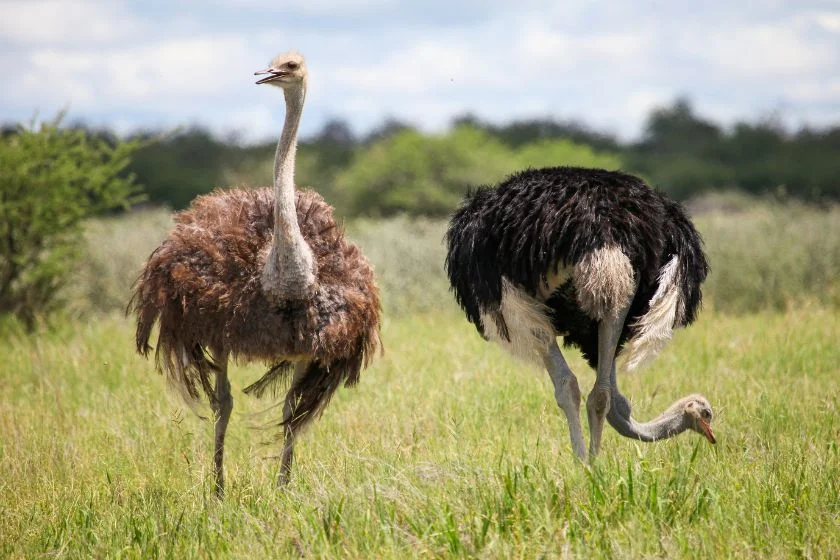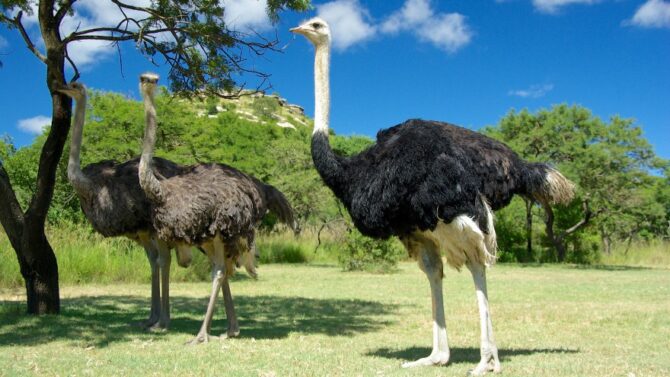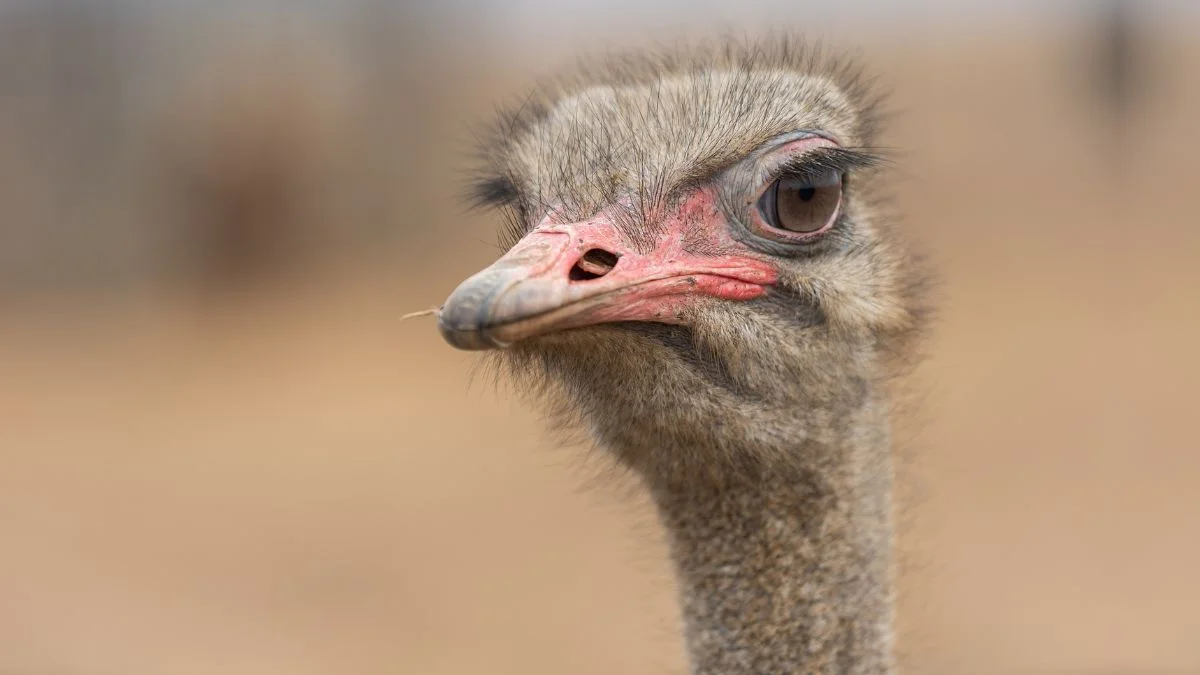The ostrich is an unusual-looking bird that belongs to the genus Struthio in the order Struthioniformes.
There are only two living species in our world today: the common ostrich and the Somali ostrich. Both come together to give us this flightless bird with long legs.
Ostriches make up for their inability to fly with their legs, and on that aspect, they’ve set a record.
They also have their ways of surviving, diet, reproductive strategies, and behaviors.
Scientific Classification
| Kingdom | Animalia |
| Phylum | Chordata |
| Class | Aves |
| Infraclass | Paleognathae |
| Order | Struthioniformes |
| Family | Struthionidae |
| Genus | Struthio |
| Scientific Name | Struthio camelus |
Characteristics
| Height | 6 to 9ft |
| Weight | 140 to 290 pounds |
| Venom/Poison | No |
| Skin Type | Feathers |
| Habitat | Desert and Savannah |
| Range | Africa |
| Diet | Omnivore (Main diet: Grass, roots, seeds, flowers) |
| Life span | 50 to 70 years |
| Gestation Period | 42 to 46 days |
| Conservation status | Least Concern |
5 Interesting Facts About Ostriches
1. The ostrich has a lot of records
This bird is considered the biggest in the world, as well as the fastest. It can’t fly because of its size, but its long legs can carry it over a great distance at a fast speed.
It also has the biggest eggs and the biggest eyes any land animal can have.
Another unusual quality that distinguishes it from other birds is its number of toes. Birds usually have four toes, but the ostrich has only two.
2. It has three stomachs
An ostrich has 3 stomachs rather than just one, the latter of which is more common amongst birds.
Due to the absence of teeth, these birds swallow their food whole. The three stomachs are necessary for proper digestion, or we’ll end up with a constipated bird.
The stomachs come with a long intestine necessary for digestion.
To do the work of teeth, ostriches swallow stones. The latter grinds up food, similar to what teeth do.
They swallow a lot of stones, sometimes weighing up to two pounds!
3. Their legs are powerful
Though these birds run more than they fight, their legs would make them good candidates for martial arts.
These legs are powerful and the ostrich has a strong kick, lethal enough to take down a lion! You certainly don’t want to be at the receiving end of that.
As with any animal that has strong legs (like horses), do not stand too close to this bird’s leg.
It could swing its legs in fright or as an instinctive movement and hit you, endangering your life in the process.
4. Ostriches don’t bury their heads in the sand
It’s a popular myth that keeps recurring despite many attempts to bury it (pun intended).
The belief seems to have its roots in Ancient Rome and is currently used in contemporary times to describe someone who avoids problems.
The belief states that ostriches bury their heads in the sand when endangered, a tactic to avoid seeing the predator.
However, this isn’t true. These birds don’t bury their heads in the sand.
They do have an avoidance tactic to escape predators, which is to lie down and stretch their necks.
5. The ostrich is an old bird
Fossil evidence for this bird dates back 20 million years or even more. The ostrich seemingly evolved to what we know today around 12 million years ago.
This marks it as a very old bird, though certainly not the oldest.
There were once other species that moved from Africa to the Eurasian regions, but these species have gone extinct.
General Description
The ostrich’s main colors are white, black, grey, brown, and even pink. It often combines colors, a popular one being black and white.
Its neck is usually without feathers, giving it that look we all know it for. Being the biggest bird in the world, the ostrich is unique. It does have a smaller lookalike, the emu.
This bird stands up to 9 inches and weigh up to 287 pounds. Its neck is always long and sinewy, and it has strong beaks.
The legs are also long and devoid of feathers just like the neck and head.
Seeing as it can’t fly or even jump high as cocks do, one would wonder what the wings are for.
Wings play the role of balance when the ostrich is walking or running as our hands do.
Males also use their wings to court the female. The feathers are not sturdy, and they are not waterproof.
Behavior
If you haven’t figured it out yet, ostriches are social creatures. They don’t always live in large groups, though. During the breeding season, they form groups of 5 to 50 birds for mating purposes.
After that period, they move into small groups of 2 to 5 units.
They can coexist with other animals like antelopes and zebras but are very territorial towards other ostrich flocks.
Intrusion is frowned upon in this world, and those in a particular territory will fight to keep others off. Their fights can get bloody.
Ostriches don’t have sweet-sounding vocals that you would expect from many birds. On the contrary, the males make what sounds like a hiss and a roar. This is usually in form of a warning.
The bird prefers to flee than fight a predator, which is probably what popularized the myth that it buries its head in sand. However, it will use the kick when necessary.
A day well spent is a day when it looks around and gathers enough food.
Unless interrupted by a predator or any other circumstances, its day-to-day life outside breeding season is spent looking for food.
Ostriches in the savannahs don’t have many problems with food, but those in deserts have to work harder.
Also, these birds like to take a bath! They may not drink water much, but they enjoy finding a large waterbody that they can use to clean themselves up.
Distribution and Habitat
Ostriches once had a wider range, extending towards Europe and Asia. However, the sad extinctionof some species has narrowed the range.
Overhunting and exploitation led to the eventual waterloo of some of these species.
The common ostrich and the Somali ostrich are the only ones left, and they can both be found in Africa.
A few individuals can be found in Australia, but the African continent is where these animals live more.
The common ostrich is located in Sub-saharan Africa while the Somali ostrich stays in the Horn of Africa.
Preferred habitats are deserts and the savannah. It also inhabits woodlands.
Ostrich Diet
Ostriches are omnivores, a trait they share with many other birds. Their preferred diet seems to be more plant material than animals as it consumes more seeds, plants, and flowers.
It does hunt down live prey and eats, consisting of animals like insects and reptiles. Animals serve more as supplements than the main meal.
The long intestine the bird possesses serves to take out the nutrient in the food.
The stones (and sometimes sand) that it eats alongside the food are for grinding purposes, and it is with an organ called the gizzard that the ostrich grinds its meal.
A surprising dietary fact is that this bird can last for long without water, going into days. Ostriches lose weight with their water habit, but it helps them in desert regions
Mating and Reproduction Process
Just like many other animals, ostriches have a breeding season. This often falls between March and September.
The male initiates the courting with an intricate movement resembling a dance.
This is done with both arm feathers and tails. It bows, shakes its feathers, and bobs its tail. The dance is a display of the male’s health and strength.
As polygamous birds, the male will often end up mating more than 3 females at a time. However, it doesn’t bond with all of them.
The most territorial male seeks out the most dominant female and bonds with her, leaving other females for the remaining males to mate with.
Ostriches incubate their eggs together, giving the latter better chances of surviving than if they were incubated alone.
The dominant female’s eggs have the best chances of surviving because she places them at the center.
Incubation is done in a communal nest in which up to 60 nests can stay. The females lay around 7 to 10 eggs in a day.
When they regroup all the eggs, both the male and female take turns guarding the nest.
In the next 42 to 46 days, the eggs start hatching into little bird babies. Each newborn is the size of a chicken. After hatching, the families all leave the nest.
Ostriches care for their young ones, and their instinct makes them defend their babies from predators or protect them from harsh weather.
The babies experience rapid growth, and they gain full size at 6 months. Sexual maturity comes after 3 to 4 years.
Ostrich Predators and Threats
Humans pose the biggest threats, and we’re responsible for the birds that got extinct.
The overhunting and exploitation of feathers are just some human activities that didn’t serve the ostrich well.
Ostrich farming reduced hunting activities on this animal, but the dangers humans bring haven’t died down yet.
Then we have animal predators. The ostrich’s size doesn’t make it an apex predator, and it is preyed upon by many other vicious carnivores like lions, leopards, cheetahs, and hyenas.
Some other animals don’t attack adults but go after the eggs. These concerns animals like vultures, warthogs, and mongooses.
The bird’s speed comes as an advantage when evading predators as only cheetahs can match the speed.
Other predators tend to lie in wait for the ostrich to go by before pouncing on it.
Ostriches can also use their kicks to wade off predators. Seeing as it can kill a lion, this is an effective tactic.
Male vs Female

The male and female can be differentiated with ease, unlike some other birds where it is hard to tell two sexes apart.
With simple observation, you should be able to tell which is the male and which is the female.
The first major difference is the size. The male is bigger than the female, both in height and weight. Here’s the difference in measurement:
- Males grow up to 9 inches while females often stop at 6.
- Males weigh up to 287 pounds while females weigh up to 242 pounds.
The next difference is in coloring. Males come with distinct black feathers, but females tend to be light brown.
During mating periods the male’s beak and shins become red while the female own turns silver.
Finally, there’s a difference in behavior. Males initiate courting, and they are more likely to attack a predator than females.
Males also make a harsh, vocal sound that females are not known to do.
Frequently Asked Questions
Are there ostriches at the zoo?
Yes, some ostriches can be found at zoos, even in the United States. Though the ostrich isn’t a native of the United States, many zoos in the country own one.
Are ostriches dangerous?
While it wouldn’t attack a human on a whim, ostriches are dangerous and can kill a person. The kick is often lethal, both to humans and large predators. You should avoid getting too close to an ostrich or even trying to scare it.
Does the ostrich migrate?
Ostriches do not migrate. Their range and habitat don’t have winter seasons, so there is no need for them to. They often remain at a particular place for a long period.
Final Thoughts
The ostrich is a unique bird with a lot of ‘awards’ to its name. It is the biggest living bird, the fastest bird, the land animal with the biggest eye, and the bird with the biggest eggs.
It is fortunate that we still have these birds in existence today, and we hope it remains that way for years to come.

